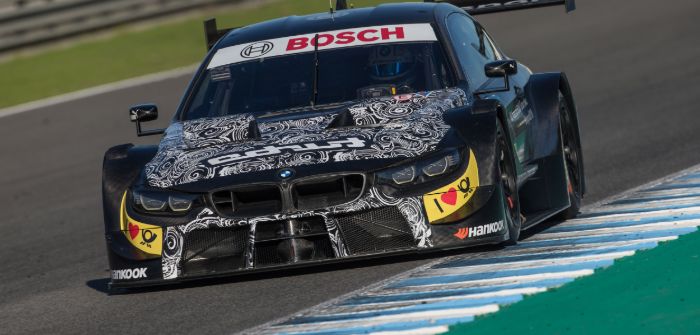BMW M Motorsport has built its most powerful DTM car ever. At the heart of the BMW M4 DTM, which has been modified in accordance with Class 1 regulations, is the newly developed BMW P48 2-liter turbo engine. Combined with significant lightweighting, the racer will reach speeds of up to 300km/h.
But 2019 is a step change. There a number of differences between this season’s race car and the 2018 version.
The biggest innovation in the BMW M4 DTM is the engine. The 4-liter V8 engine P66 has been replaced by a state-of-the-art, newly developed turbo engine – the P48. The capacity of this power unit is only half that of its V8 predecessor, yet it generates more power with less consumption. Like the BMW production engines, the P48 is a turbocharged, straight 2-liter engine with direct fuel injection.
The exhaust system had to be redesigned completely for the new turbo engine. The M4 DTM, in accordance with Class 1 regulations, has a much shorter exhaust pipe on only the right side of the car. The end of the exhaust pipe is located toward the center of the door, next to the vents. Unlike in the past, there is no second exhaust pipe on the left side of the car.
The DTM has introduced a push-to-pass function for the first time. This means the drivers can call on up to 30ps of extra engine power. This is possible using a fuel flow restrictor. The increase in power is achieved by temporarily allowing more fuel to be injected into the four cylinders.
The rear wing is 520mm wider than that on the 2018 car. It also has just one section. DTM adopted the concept of the standard part from the Japanese Super GT championship. The rear wing still has DRS, in the form of a pneumatic flap mechanism, which reduces the amount of aerodynamic drag generated by the car.
The mandatory weight of the new car, when empty, is now less than 1,000kg. The car must now weigh a minimum 981kg without driver or fuel. That is 50kg less than last season.
The combination of more engine power and less weight means the BMW M4 DTM has a significantly lower power to weight ratio of 1.6kg/hp. This aims to ensure that the cars reach the 300km/h mark on the fastest sections of track on the DTM calendar, such as the Parabolica at the Hockenheimring.
The size of the cooling vents in the bonnet has also been increased significantly for the intercooler of the 2-liter turbo engine. The protrusion of the front splitter has been reduced by up to 90mm. This modification makes the BMW M4 DTM more robust in wheel-to-wheel battles.
The diffuser has been lowered by 30mm and the start of the diffuser ramp has been moved back 870mm. The vent on the rear windshield of the BMW M4 DTM is also new and enables optimized ventilation of the interior.
Other than that, the aerodynamics remain unchanged compared to 2018. With this combination of tried-and-tested and modified aerodynamic components, the focus shifts even more firmly toward the driver. At the same time, it avoids an aerodynamic arms race between the manufacturers.



